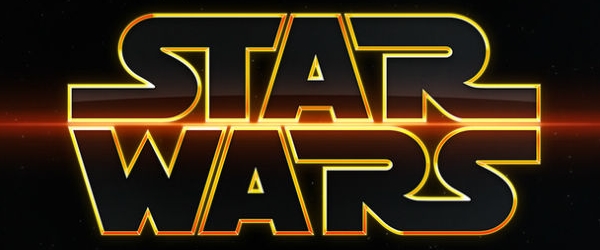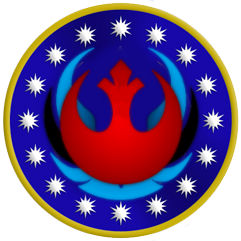Difference between revisions of "Alliance of Free Planets"
From TheHolo.Net Forums Wiki
(→Alliance Members) |
|||
| Line 1: | Line 1: | ||
| − | {{ | + | {{Infobox_SWOrganisation |
| Title=Alliance of Free Planets | | Title=Alliance of Free Planets | ||
| Image=Alliance.jpg | | Image=Alliance.jpg | ||
Revision as of 10:34, 2 November 2014

Characters - Organizations - Locations - Timeline - Species - Ships
Mutual Defense Pact
Central Government
Contents |
Alliance Government
The government of the Alliance of Free Planets is an awkward mix of the old leadership of the Alliance to Restore the Republic, the even older leadership of the Galactic Republic, and new concepts implemented to fit the specific needs of the Alliance of Free Planets, and to avoid the type of totalitarian government that had existed under the Galactic Empire. While it strove to see a return to the kind of Senate representation that the Empire had abolished, it also sought to avoid the loopholes that Palpatine had exploited to seize power, and to distance itself from the kind of regionalised, federalised governance and military law that Palpatine and his Moffs had used to rule through force and fear.
Chief of State
The Alliance of Free Planets is led by the Chief of State, an individual elected by a Representative Vote of the Alliance Senate. The Chief of State does not serve for a fixed term, instead retaining the position until they choose to retire, or are removed from office by a vote of no confidence on the part of the Senate. The first and incumbent Chief of State is Mon Razien, who had served as leader of the Alliance to Restore the Republic since shortly after the Battle of Endor.
Council of Ministers
See: Alliance Council
Appointed by the Chief of State, the Alliance Council of Ministers - often referred to as the Alliance Council or ACOM (pronounced ay-com) - was an evolution of the Alliance Advisory Council that had existed as part of the Alliance to Restore the Republic. Rather than representatives of significant worlds within the Alliance however, they instead represent specific fields of interest that are relevant to the leadership and decision-making of the Chief of State, advising on issues such as defense, economics, foreign policy, education, and more.
- Minister of State - Salem Ave
- Minister of Defense - Torrsk Oruo'rel
- Minister of Justice - Ulys Caed
- Minister of Industry - Niev Minetii
- Minister of Commerce - Jaanseerra Arretaura
- Minister of Science - Bils Kir'nir
- Minister of Supply - Tukphen
To date, all members of the Alliance Council have also been Senators; however, the Alliance Constitution stipulates only that all appointments must be ratified by a Restricted Vote of the Alliance Senate.
Alliance Senate
See: Alliance Senate
The legislative branch of the Alliance of Free Planets is the Alliance Senate, which assembles on Bothawui to discuss matters as diverse as farming and foreign policy. The structure of the Senate is specifically designed to prevent any one species or culture - Human or otherwise - from having a disproportionate majority in any political decisions. As a result of this, the number of Senators is strictly controlled: no cohesive political area (currently Bothan Space, Mon Calamari Space, the Carshoulis Cluster, and the Hapes Consortium) is permitted to have more than two full Senators.
All worlds are entitled to Representatives however, and other entities such as trade guilds and governments-in-exile have been permitted this level of involvement in government as well. Most issues regarding law and policy are put to a Representative Vote first, to gauge a widespread consensus, which then guides any subsequent government decisions on the matter. Some issues however, such as the approval of military funding, military action, and emergency aid, is put to a Restricted Vote of only Senators who, in theory, represent "a sufficient and significant majority of opinion regarding strategy, diplomacy, and economics".
- Celeste Starborn - Senator for New Alderaan, Speaker of the House
The Alliance Senate additionally operates a number of Senate Committees, Subcommittees, Commissions, and Coalitions, which debated and devised the proposals that were brought before the Senate. These included the Defense Oversight Committee, the Senate Aid Commission, and the Alliance Security Council.
Alliance Military
While the military of the Alliance to Restore the Republic had been a mobile guerilla force with only a handful of sectors to defend, the military of the Alliance of Free Planets had to contend not only with a vast increase in territory, but also with being a military force operating in peacetime. Tactics that the Alliance had employed before, such as smuggling and privateering, suddenly became threats to be contended with, in a manner that reflected the Empire's actions against them as little as possible. The military also had to integrate a disparate and assorted spectrum of national military forces from the Alliance's new members and territories.
While the Alliance has a respectable Fleet, it does not have any sort of standing army, relying on SpecForce, the Fleet's Marine Corps, and regional Sector Forces to provide ground troops where required. Whenever possible, national militaries and security forces are left under the authority of their sovereign states.
Alliance Defense Forces
Formed after the Alliance-Imperial Treaty to place Admiral Reshmar in command of the Alliance's unified military, the Alliance Defense Forces. All military assets were placed under the Supreme Commander's authority, including the Alliance Fleet, the Alliance Starfighter Corps, Alliance SpecForce, and a newly-constituted Alliance Marine Corps. The Defense Force was tasked with preserving the sovereignty of the Alliance's borders and worlds from threats of a military nature; however, to avoid reflecting the totalitarian regime and martial law of the Galactic Empire, certain key elements were left in the hands of Alliance Intelligence and Alliance Security, to act as safeguards against each other.
The leadership of the Alliance Defense Forces was arranged into the Alliance High Command:
- Supreme Commander - Admiral Reshmar
- First Fleet (Response) - Admiral Holt
- Second Fleet (Dac) -
- Third Fleet (Onderon) -
- Royal Hapan Navy - Admiral Trance Farani
- Fourth Fleet (Bothawui) - Admiral Vansen Tyree
- Fifth Fleet (Sluis Van) - Admiral Crotalus Viridis
- Alliance Marine Corps - General Forlon
- Alliance Starfighter Corps - General Meiers Brecklin
- Alliance Special Forces - General Regulus Starborn
The headquarters of Alliance High Command and many of it's branches was on Bothawui. The Alliance Fleet and Marine Corps however retained their traditional headquarters on Dac. The Defense Forces were overseen on behalf of the Alliance Senate by the Defense Oversight Committee.
Alliance Intelligence
Already an intricate network of intelligence agencies during the Alliance to Restore the Republic, Alliance Intelligence was maintained as a separate agency independent of the Alliance Defense Forces, to prevent any one agency - and any one commander - from having complete control over both the Alliance's military and clandestine operations. However, Alliance Intelligence was given jurisdiction over the former Alliance SpecOps division, to ensure that all Special Operations were conducted with the appropriate level of oversight and accountability.
- Director of Alliance Intelligence - Grace Van-Derveld
Alliance Intelligence was headquartered in the Intergalactic Trade Mission on Bothawui: the traditional headquarters of the Bothan Spynet. The Intelligence Oversight Committee provided accountability for the agency's activities, scrutinising the viability, morality, and legality of potential Alliance Intelligence missions.
Alliance Security
See: Alliance Security
Similar to the Republic Judicial Forces that had existed prior to the Clone Wars, Alliance Security was created to reflect the roles of the Imperial Security Forces and Imperial Sector Rangers, providing a federal agency that was responsible for interstellar law enforcement, counter-intelligence, national security, and customs enforcement: an important part of preserving the absence of martial law. Alliance Security had access to a small fleet of interdictor cruisers and customs frigates, as well as operational jurisdiction over any local law enforcement agencies within Alliance Space.
- Director of Alliance Security - Dasquian Belargic
Alliance Security also functioned as the protection and security detail of the Alliance Senate and the Alliance government's leadership, in lieu of a separate Senate Guard or similar agency.
Alliance Members
Any planet, system, corporation-colony, or government within the Sectors defined as Alliance Space under the Alliance-Imperial Treaty is eligible to petition for membership of the Alliance of Free Planets. In order to be considered an Alliance World, a government must be representative of the world's entire population, either as a single central government, or as a petition submitted with the accent of other relevant parties. Unilateral control of a star system or sector is not mandatory however: there are systems within the Alliance where one inhabited world is a member of the Alliance, but others are not. Once accepted, the Alliance World is invited to send a Representative to the Alliance Senate, and becomes subject to the protection of the Alliance Defense Forces, as well as subject to the stipulations of it's constitution and laws.
In addition, the Alliance Senate has been known to grant Representatives to non-geographic entities, such as the Verpine corporation-colony of Slayn & Korpil, which consists of a sizeable population of Verpines translocated to Dac during the Galactic Civil War; and the Lantillian Spacers' Brotherhood, a commerce guild endorsed by the Alliance Senate that licences all freight and passenger traffic within Alliance Space.
Species
These species are resident as significant/dominant populations (ie. worlds, colonies, governments) on Alliance worlds. Species in bold are native to the region: their homeworld is an Alliance member.
- B'Trillan
- Bith
- Bothan
- Byss
- Caamasi
- Celgian
- Chadra-Fan
- Cizerack
- Clawdite
- Coynite
- Dug
- Duros
- Dresselian
- Elom
- Elomin
- Gand
- Gossam
- Gran
- Gungan
- H'Nemthe
- Hoojib
- Human
- Ithorian
- Keed
- Kon'me
- Krantian
- Lahsbee / Huhk
- Meri
- Mirialan
- Mon Calamari
- Mustafarian
- Omwati
- Orfite
- Ortolan
- Pau'an
- Quarren
- Quermian
- Sluissi
- Sullustan
- T'Sarki
- Tai'ni
- Talid
- Teltior
- Umbaran
- Utai
- Veknoid
- Verpine
- Vorzydiak
- Wookiee
- Woostoid
- Xan
- Xexto
- Ysanna
- Zolander
Sectors
See: Alliance Space
Homeworlds
These worlds are the homeworld of one or more species. Planets in bold are represented by a Senator.
- Abyss
- Algara II
- Ando Prime
- Arbra
- B'Trilla
- Bal'demnic
- Bothawui - capital
- Carshoulis Prime
- Celigia
- Chad
- Clak'dor
- Coyn
- Dac
- Di'tai'ni
- Dressel
- Elom
- Gand
- H'Nemthe
- Hapes *
- Kalishik
- Kashyyyk
- Keedad
- Kidron
- Krant
- Lahsbane
- Malastare
- Merisee
- Mirial
- Moonus Mandel
- Mustafar
- Naboo *
- Omwat
- Orto
- Quermia
- Roche
- Sluis Van
- Sullust
- Troiken
- Umbara
- Utapau
- Vorzyd
- Woostri
- Zolan
Human Worlds
These worlds are populated mostly by humans. Planets in bold are represented by a Senator.
Non-Human Worlds
These worlds are populated mostly by non-humans. Planets in bold are represented by a Senator.
Refugee Worlds
These worlds are mostly populated by refugees from worlds in Imperial space. Planets in bold are represented by a Senator.
- New Alderaan - Alderaanians
- Krinemonen III - Aquatic species
- Öetrago - Ithorians
- Ossus - Jedi, Gossam
- Presbalin - Chandrilans, Corellians
- Sanctuary - Caamasi
Unaligned Worlds
These worlds and regions are located in or near Alliance Space, but are not part of the Alliance government. Some are uninhabited. Planets in bold are represented by an Ambassador.


